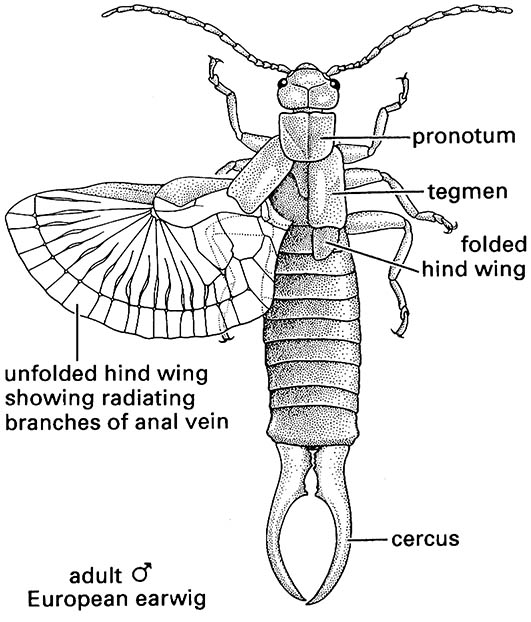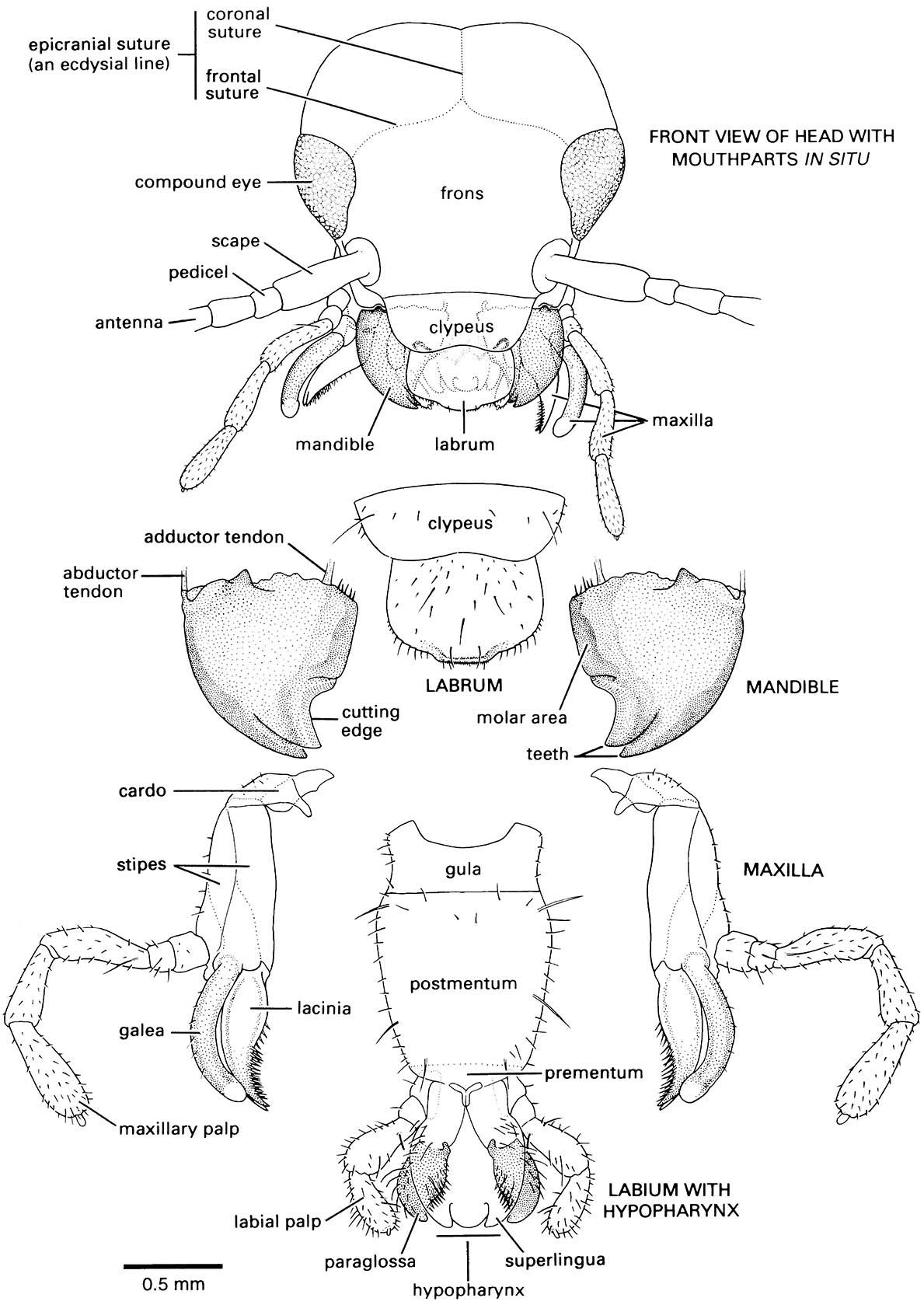Box 9.7. Dermaptera (earwigs)
The earwigs comprise an order containing some 2000 species in about 10 families found worldwide. They are hemimetabolous, with small to moderately sized (4–25 mm long) elongate bodies that are dorsoventrally flattened. The head is prognathous; the compound eyes may be large, small, or absent, and ocelli are absent. The antennae are short to moderate length and filiform with segments elongate; there are fewer antennal segments in immature individuals than in the adult. The mouthparts are mandibulate (section 2.3.1; Fig. 2.10). The legs are relatively short, and the tarsi are three-segmented with the second tarsomeres short. The prothorax has a shield-like pronotum, and the meso- and metathoracic sclerites are of variable size. Earwigs are apterous or, if winged, their fore wings are small and leathery, with smooth, unveined tegmina; the hind wings are large, membranous, and semi-circular (as illustrated here for an adult male of the common European earwig, Forficula auricularia) and when at rest are folded fan-like and then longitudinally, protruding slightly from beneath the tegmina; hind-wing venation is dominated by the anal fan of branches of A1 and cross-veins. The abdominal segments are telescoped (terga overlapping), with 10 visible segments in the male and eight in the female, terminating in prominent cerci modified into forceps; the latter are often heavier, larger, and more curved in males than in females.
Copulation is end-to-end, and male spermatophores may be retained in the female for some months prior to fertilization. Oviparous species lay eggs often in a burrow in debris (Fig. 9.1), guard the eggs and lick them to remove fungus. The female may assist the nymphs to hatch from the eggs, and may care for them until the second or third instar, after which she may cannibalize her offspring. Maturity is attained after four or five molts. The two parasitic groups (of uncertain rank), Arixeniina and Hemimerina, exhibit pseudoplacental viviparity (section 5.9).
Earwigs are mostly cursorial and nocturnal, with most species rarely flying. Feeding is predominantly on dead and decaying vegetable and animal matter, with some predation and some damage to living vegetation, especially in gardens. Some are commensals or ectoparasites of bats in south-east Asia (Arixeniina) or semi-parasites of South African rodents (Hemimerina): earwigs in both tribes are blind, apterous, and with rod-like forceps. The forceps of free-living earwigs are used for manipulating prey, for defense and offense, and in some species for grasping the partner during copulation. The common name “earwig” may derive from a supposed predilection for entering ears, or from a corruption of “ear wing” referring to the shape of the wing, but these are unsupported.
Phylogenetic relations are discussed in section 7.4.2 and depicted in Fig. 7.2.


Note that the head is prognathous and thus a gular plate, or gula, occurs in the ventral neck region.

Note that organisms living on the soil surface and in litter have longer legs than those found deeper in the ground. Organisms occurring deep in th e soil usually are legless or have reduced legs; they are unpigmented and often blind. The organisms depicted are: (1) worker of a woo d ant (Hymenoptera: Formicidae); (2) springtail (Collembola: Isotomidae); (3) ground beetle (Coleoptera: Carabidae); (4) rove beetle (Coleoptera: Staphylinidae) eating a springtail; (5) larva of a crane fly (Diptera: Tipulidae); (6) japygid dipluran (Dip lura: Japygidae) attacking a smaller campodeid dipluran; (7) pupa of a ground beetle (Coleoptera: Carabidae); (8) bristletail (Archaeognatha: Machilidae); (9) female earwig (Dermaptera: Labiduridae) tending her eggs; (10) wireworm, larva of a tenebrionid beetle (Coleoptera: Tenebrionidae); (11) larva of a robber fly (Diptera: Asilidae); (12) larva of a soldier fly (Dipt era: Stratiomyidae); (13) springtail (Collembola: Isotomidae); (14) larva of a weevil (Coleoptera: Curculionidae); (15) larva of a m uscid fly (Diptera: Muscidae); (16) proturan (Protura: Sinentomidae); (17) springtail (Collembola: Isotomidae); (18) larva of a March fly (Diptera: Bibionidae); (19) larva of a scarab beetle (Coleoptera: Scarabaeidae). (Individual organisms after various sources, especially Eisenbeis & Wichard 1987)

Broken lines indicate uncertain relationships. Thysanura sensu lato refers to Thysanura in the broad sense. (Data from several sources)



